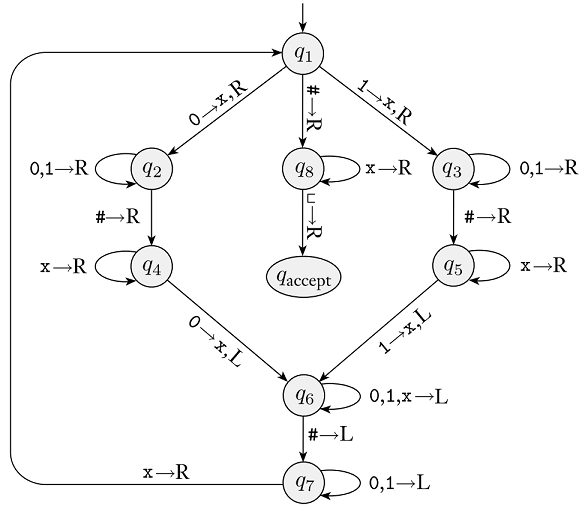Homework 6
Last updated: Fri, 11 Mar 2022 18:36:52 -0500
Out: Mon Mar 07, 00:00 EST Due: Sun Mar 20, 23:59 EST (Note: after Spring Break)
This assignment begins to explore Turing Machines and their languages.
Homework Problems
Not a Context-Free Language (8 points)
Turing Machine Config Sequences (6 points)
Flashback: Closed Operations for Regular Languages (5 + 5 = 10 points)
Closed Operations on Turing-Recognizable Languages (5 + 5 = 10 points)
README (1 point)
Total: 35 points
Submitting
Submit your solution to this assignment in Gradescope hw6. Please assign each page to the correct problem and make sure your solutions are legible.
A submission must also include a README containing the required information.
1 Not a Context-Free Language
Prove that the following language of "states":
D = \left\{ q_1\texttt{\#}\cdots\texttt{\#}q_n\texttt{\#}q_0 \mid n\geq 1\textrm{, each }q_i\textrm{ is a string of len}> 0\textrm{, and }q_0 = q_j\textrm{ for some }j\geq 1\right\}
is not a context-free language.
You may assume the alphabet of the language is \Sigma = \{\texttt{\#},\texttt{a},\texttt{b},\texttt{c}\}, but that state name strings only use characters in \{\texttt{a},\texttt{b},\texttt{c}\}.
\texttt{a\#b\#a}
\texttt{aa\#bb\#bb}
\texttt{aa\#aa}
\texttt{a}
\texttt{aa\#\#bb}
\texttt{a\#b\#c}
2 Turing Machine Config Sequences
Here is the example Turing Machine from class (it’s also Figure 3.10 in Sipser textbook):

Remember that transitions for any input characters that are not explicitly included goes to an implicit q_{reject} state. Also, if a transition does not specify a character to write, then the tape contents stay the same.
0#0
10#10
10
##11
3 Flashback: Closed Operations for Regular Languages
Define the following operation, called \mathrm{NOTIN}, on languages:
\mathrm{NOTIN}(A)=\{w\mid w \notin A\}
Prove that \mathrm{NOTIN} is closed for regular languages.
Define the following operation, called \mathrm{BOTH}, on languages:
\mathrm{BOTH}(A,B)=\{w\mid w \in A\textrm{ and }w \in B\}
Prove that \mathrm{BOTH} is closed for regular languages.
4 Closed Operations on Turing-Recognizable Languages
Prove that the \mathrm{BOTH} operation (from the Flashback: Closed Operations for Regular Languages problem) is closed for Turing-recognizable languages.
To further show that your answer is correct, create a table of possible Turing machine outcomes, like the ones from lecture, that show all possible combinations of results from all of the Turing machines involved in your answer.
Create a table of possible Turing machine outcomes, like the ones from lecture, that show what a hypothetical Turing machine would need to do in order to prove that the \mathrm{NOTIN} operation (from problem Flashback: Closed Operations for Regular Languages) is closed for Turing-recognizable languages.
Then comment on why it might not be possible to prove that the \mathrm{NOTIN} operation is closed for Turing-recognizable languages.